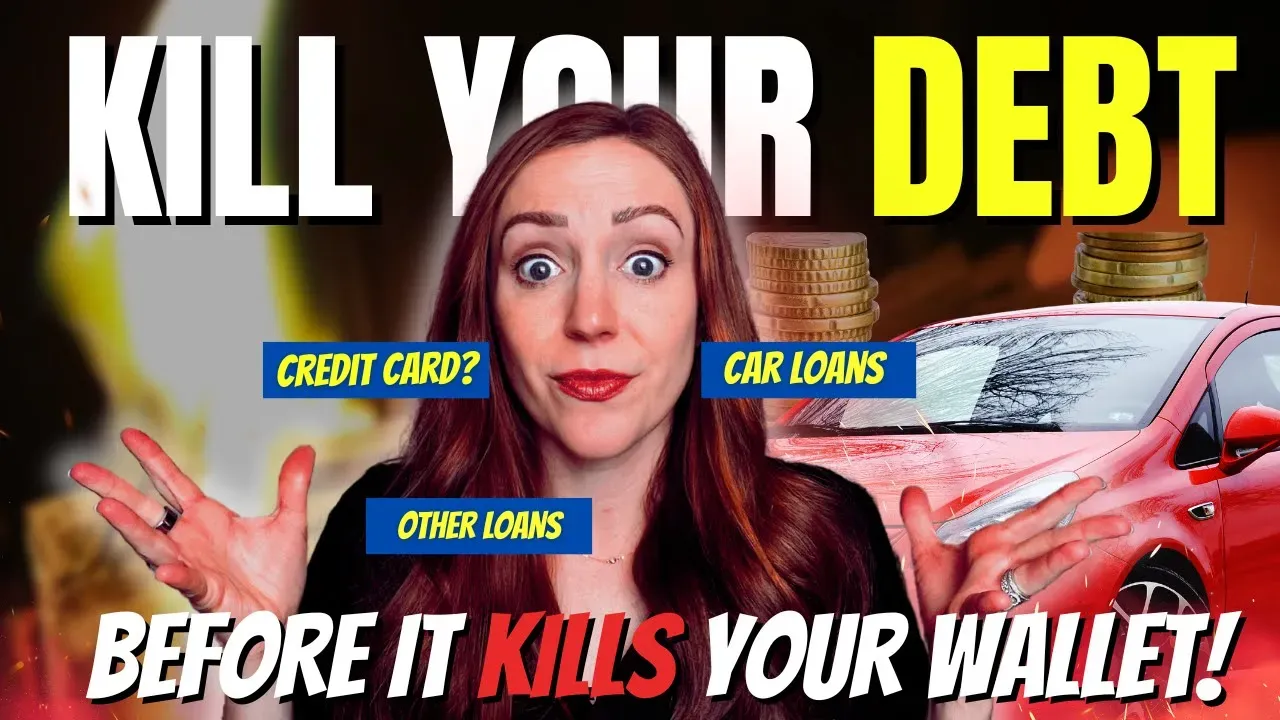Binge read all things wealth building, debt reduction, & lifestyle.
The Debt Avalanche Strategy Every Medical Professional Needs to Know in 2025

If you're a PA, NP, or pharmacist with any debt that's causing you stress, this guide is for you.
Forget random payment orders or blind budgeting apps. It's time to get strategic about your debt and your future wealth. In this blog, you'll learn the smarter way to tackle debt (hint: it's not the snowball method), how to save thousands in interest, and when to start investing while still paying off loans.
Snowball vs. Avalanche: What Actually Saves You Money?
You've likely heard of the Debt Snowball, a method where you pay off the smallest debt first regardless of interest rate. It's emotionally satisfying, sure. But if you're carrying any high-interest debt (like credit cards or personal loans), it's costing you thousands more over time.
Instead, opt for the Debt Avalanche strategy:
- Step 1: List your debts from highest to lowest interest rate (not balance).
- Step 2: Make minimum payments on all debts.
- Step 3: Throw all extra payments at the highest-interest debt first.
💡 Exa...
How to Save as a PA-C (or Any Medical Professional Earning $100K+)

If you're a PA, NP, or pharmacist earning over $100K a year but your savings account still looks like it belongs to your student days... you're not alone.
I became a millionaire by age 31, not by winning the lottery or flipping houses—but by mastering the basics: saving, investing, and being intentional with money. In this post, I’ll walk you through how to calculate your real savings rate, strategies to save more without sacrificing joy, and how to build wealth faster.
Step 1: Know Your Actual Savings Rate
Most medical professionals have no idea what their savings rate is. If that’s you? Let’s fix that.
To find your savings rate:
- Add up ALL dollars you put toward true savings and investments each month. That includes:
- Emergency fund deposits (your sinking funds for vacations don’t count)
- 401(k), 403(b), or other employer retirement plan contributions
- Roth IRA or brokerage account deposits
- HSA contributions
- Then divide that number by your gross monthly income (not your ...
From $0 to $1.2M in 7 Years: How PAs Can Become Millionaires Faster Than You Think

What if I told you that it’s possible to go from zero to over a million dollars invested in just 7 years on a PA salary?
No gimmicks. No crazy frugality. No lottery luck.
Just a clear, proven 3-step strategy any driven PA can follow.
Let’s break it all down.
Step 1: Cross the $200K Mark with Your Primary Job
This is where most PAs tap out, but it’s also where the biggest growth potential starts.
📊 According to data from Marit Health, 1 in 14 PAs already earn over $200K/year.

Here’s how to increase your odds of joining them:
✅ Choose a High-Earning Specialty:
Dermatology, critical care, cardiothoracic surgery, and PM&R consistently top the list. But it’s not just about the specialty—it’s about where you land within it.
💡 Specialties like dermatology, plastic surgery, and psychiatry have high intraspeciality variance in pay, meaning some PAs are crushing $200K+ while others are barely above average. Don’t just switch specialties… switch to a better-paying role within your speci...
Top Paying PA Specialties in 2025: Where Physician Associates Are Earning the Most (and Least)

If you're a practicing PA, a PA student, or even considering PA school, you're probably asking yourself: Is the debt worth it? The good news? PA salaries are going up. The better news? You have more control over your income than you might think.
PA Salaries Are On the Rise (But Uneven)
According to the latest AAPA Salary Report, PA earnings rose 5.5% in 2024 alone. MGMA data shows:
- Surgical PAs: median is up 15% since 2020
- Non-surgical, non-primary care PAs: median is up 21%
- Primary care PAs: median is up 30%
Sounds great for primary care, right? Not so fast. That percentage growth only tells part of the story. You need to look at absolute numbers and actual earning potential across subspecialties.
The 3 Highest Paying PA Specialties in 2025

Using Marit Health salary data, these are the current top-paying specialties:
- Dermatology — Average: $166K/year
- Avg. weekly hours: 37
- Also has highest percent of PAs earning $200K+
- Critical Care — (as a critical care PA myse...
How to Make Your Kid a Millionaire by Age 35 (Yes, Really)

If you're a medical professional and either have kids or want kids someday, you've probably wondered:
How can I give them a financial head start I never had?
Let me show you how we’re doing it.
I’ve set up a system where both of my kids will be millionaires by the time they’re 35—and it doesn’t require hundreds of thousands of dollars.
It just takes intention, a few monthly contributions, and the right accounts.
First—This Is Not All or Nothing
Let me be clear:
You don’t need to hit millionaire status for this to be worth it.
Even if you can only do a fraction of this plan, you're still setting your kid up with a financial launchpad that most of us never had.
Even $100/month over time = six figures by adulthood. That’s still a huge win.
But if you do want to go all in, here’s exactly how we’re making millionaire status happen by age 35:
Step 1: Open a UTMA Account
We start with a UTMA account (Uniform Transfers to Minors Account)—
✅ It’s flexible
✅ It’s taxable
✅ And the mone...
How to Build Wealth When the Economy Feels Like a Dumpster Fire

Spring 2025 came in hot with tariff wars, rising inflation, student loan chaos, and stock market volatility that has a lot of medical professionals wondering...
“Is it even possible to build wealth in a season like this?”
Short answer: yes.
But you need a strategy—and some serious emotional discipline.
Why Personal Economics > Macroeconomics
The truth? You could come out of this economic mess ahead—if you have your personal financial systems dialed in.
✅ No high-interest debt
✅ 3–6 months of cash reserves
✅ Multiple income streams
✅ A student loan plan
✅ A long-term investing system
If you don’t have these in place, this season can wreck you.
If you do? You can use it to build wealth while everyone else panics.
What Investing in a “Down Market” Actually Feels Like
Whether you’re:
- A new investor putting in your first $1,000
- Or a seasoned one watching $70K disappear from your account in a day
It still stings.
But this is where people either panic and pull out...
Or keep go...
What Most New Grad PAs Realize After Their First Paycheck

You graduate. You pass your boards. You land the job.
That six-figure paycheck hits—and then... reality sets in.
If you’re a brand new PA, you know exactly what I’m talking about.
It’s not quite the dream you imagined. Expenses feel overwhelming. Loans are looming. And you’re wondering, “Wait… where did my paycheck go?”
Let’s walk through exactly what you should be doing in your first year of practice to get your money right.
Why Generic Budget Rules Don’t Work for PAs
You’ve probably heard of those 50/30/20 budgeting rules:
- 50% to needs
- 30% to wants
- 20% to savings/investing
I hate those.
They’re made for the masses—not for people like us.
If I followed that rule? I wouldn’t be a millionaire by 31. I needed a lot more than 20% going toward debt and wealth-building.
What you really need is a cash flow system that helps you grow your net worth—not just track your spending.
Inside the Millionaires in Medicine Club, I break down exactly how to do this with a free tracker you c...
How I’m Making My Kids Millionaires... Without Spoiling Them

Yep, you read that right. It's totally possible to turn your kid into a future millionaire—without needing to throw in hundreds of thousands.
I’m doing it with just a few thousand dollars and a lot of intention. And in this blog, I’ll show you exactly how:
👉 The accounts we use
👉 The money system we teach our 3-year-old
👉 And the mindset shifts that actually matter more than the money
Let’s break it all down.
Our Four-Bucket Money System for Kids
You’ve probably heard of the classic give-save-spend system for teaching kids about money.
I hate it.
Why? Because it completely ignores investing—arguably the most important pillar of long-term wealth.
So instead, we created our own version: Give, Save, Spend, and Invest.
Every Sunday, our 3-year-old gets her allowance in quarters (supervised, of course), and she gets to divide those coins between her four jars.
To make the “invest” jar feel real, we created a visual thermometer tracker for her investing goals, broken into:
- 🎓 Coll...
How PAs, NPs, and Pharmacists Are Building Millions (Even Without High Salaries)

If you’re a PA, NP, or pharmacist and think wealth building is only for people in higher-paying specialties or dual-income households with no debt—this blog is for you.
The truth? It’s 100% possible to become a multi-millionaire with a six-figure income, even if you’re working in primary care, living in a high cost-of-living area, or just starting out. How do we know? Because we’ve helped medical professionals just like you do exactly that.
Below are five real client case studies to show you what’s possible with the right systems, strategy, and support.
CASE 1: Kelly, a Primary Care PA, Married to an RN
Challenge: Lower-paying specialty + early 30s with limited investments
Goals: Reduce hours when they start a family, retire early with flexibility
What We Did:
- Optimized their PSLF strategy to save $600/month on student loan payments
- Reallocated that money into an investing system
- Completely overhauled their account structure and monthly contributions
Result:
Kelly and her sp...
Why I Stopped Paying for Someone To Manage My Investments, and Saved Over $1.5 Million

If you're a PA, NP, or pharmacist and you've ever thought, "Personal finance is just too complicated for me," you're not alone. That’s exactly what most of us are conditioned to believe.
But here's the truth: learning to manage your own money could save you more than $1.5 million in your lifetime. I know this because I’ve lived it.
My Story: From Student Debt to Seven Figures
When I graduated as a critical care PA, I had $161,000 in student loans and zero assets. Like many new grads, I was eager to "do the right thing", so I hired a financial advisor and opened a Roth IRA through Edward Jones.
It felt like I was checking all the right boxes. But years later, I realized I had paid thousands in fees without even realizing it: fees that were quietly dragging down my returns.
Once I learned to manage my portfolio myself, everything changed. Less than a decade later, I hit $1 million in net worth at age 31.
The Cost of Not Learning Personal Finance
Most medical professionals fall int...


